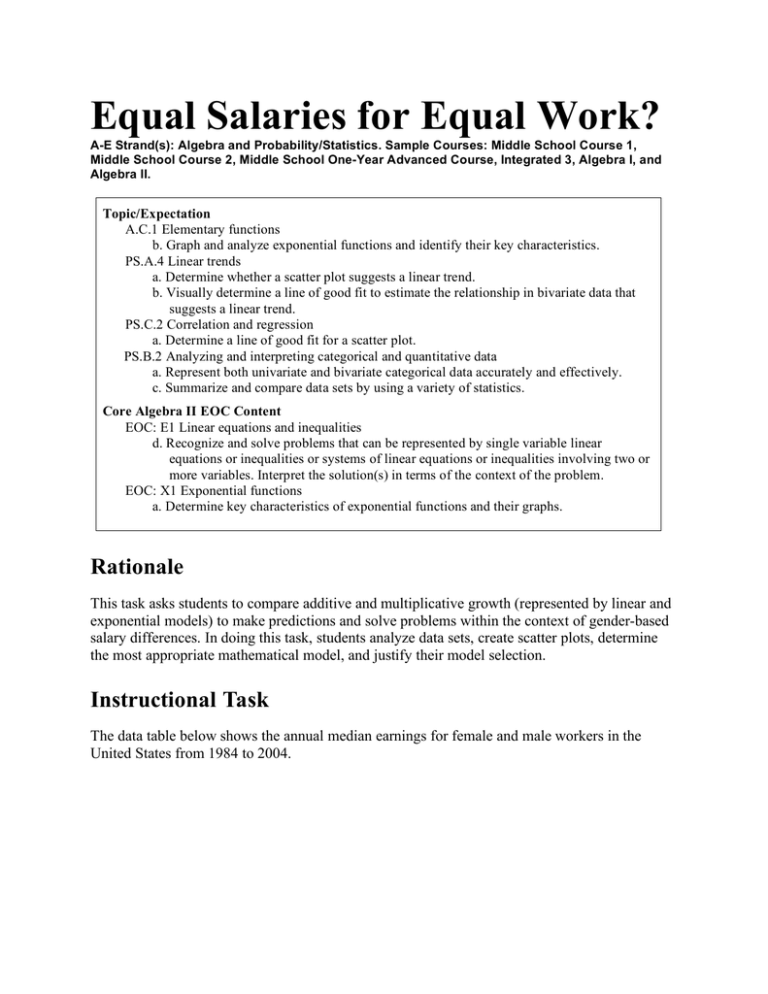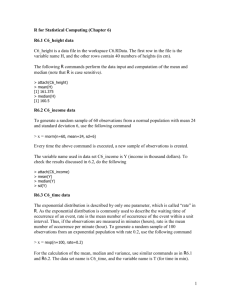Equal Salaries for Equal Work?
advertisement

Equal Salaries for Equal Work? A-E Strand(s): Algebra and Probability/Statistics. Sample Courses: Middle School Course 1, Middle School Course 2, Middle School One-Year Advanced Course, Integrated 3, Algebra I, and Algebra II. Topic/Expectation A.C.1 Elementary functions b. Graph and analyze exponential functions and identify their key characteristics. PS.A.4 Linear trends a. Determine whether a scatter plot suggests a linear trend. b. Visually determine a line of good fit to estimate the relationship in bivariate data that suggests a linear trend. PS.C.2 Correlation and regression a. Determine a line of good fit for a scatter plot. PS.B.2 Analyzing and interpreting categorical and quantitative data a. Represent both univariate and bivariate categorical data accurately and effectively. c. Summarize and compare data sets by using a variety of statistics. Core Algebra II EOC Content EOC: E1 Linear equations and inequalities d. Recognize and solve problems that can be represented by single variable linear equations or inequalities or systems of linear equations or inequalities involving two or more variables. Interpret the solution(s) in terms of the context of the problem. EOC: X1 Exponential functions a. Determine key characteristics of exponential functions and their graphs. Rationale This task asks students to compare additive and multiplicative growth (represented by linear and exponential models) to make predictions and solve problems within the context of gender-based salary differences. In doing this task, students analyze data sets, create scatter plots, determine the most appropriate mathematical model, and justify their model selection. Instructional Task The data table below shows the annual median earnings for female and male workers in the United States from 1984 to 2004. Equal Salaries for Equal Work? Year Women’s median earnings (in dollars) Men’s median earnings (in dollars) 1984 8675 17026 1985 9328 17779 1986 10016 18782 1987 10619 19818 1988 11096 20612 1989 11736 21376 1990 12250 21522 1991 12884 21857 1992 13527 21903 1993 13896 22443 1994 14323 23656 1995 15322 25018 1996 16028 25785 1997 16716 26843 1998 17716 28755 1999 18440 30079 2000 20267 30951 2001 20851 31364 2002 21429 31647 2003 22004 32048 2004 22256 32483 Data provided by U.S. Census Bureau 1. Create two scatter plots, one for women’s median earnings over time and one for men’s median earnings over time. Describe two things you notice about the scatter plots. 2. Terry and Tomas are trying to decide what type of model will most accurately represent the data. Terry thinks that a linear model might be most appropriate for each scatter plot. Help Terry find reasonable linear function rules for each scatter plot. Explain how you found these. 3. Using the linear models, will women’s annual median earnings ever equal those of men? Why or why not? Charles A. Dana Center 2 Equal Salaries for Equal Work? 4. Tomas thinks that an exponential model might be most appropriate for each scatter plot. Help Tomas find reasonable exponential function rules for each scatter plot. Explain how you found these. 5. Using the exponential models, will women’s annual median earnings ever equal those of men? Why or why not? 6. If you answered yes to either question 3 or question 5, use that model to determine the first year women will have higher median earnings than men. Explain how you found your answer. 7. For each year listed in the table, find the ratio of women’s to men’s annual median earnings expressed as a percentage. Use the data to create a scatter plot of percentage versus year. Based on this graph, do you think women’s annual median earnings will ever equal those of men? Why or why not? 8. Considering the results of the scatter plot in question 7 above, do you think the linear model or exponential model makes more sense? Why? Discussion/Further Questions/Extensions This task provides a good example of how data points can appear to be linear over a relatively small domain, but how a different type of mathematical model might be more appropriate over a larger domain. This is an opportunity for students to discuss strengths and limitations of using mathematical functions to model real data. One discussion might arise as to whether other types of mathematical functions might sometimes be used for different types of data, perhaps leading students to look for patterns in data they might gather from sources like newspapers or books of world records. Note that students will need to make a decision about the initial value representing the year. For example, it would be reasonable to assign the year 1984 (the first year in the table) as Year 0. The sample solutions below are based on this assumption. Sample Solutions 1. Create two scatter plots, one for women’s median earnings over time and one for men’s median earnings over time. Describe two things you notice about the scatter plots. Each scatterplot below is graphed with the following window: Charles A. Dana Center 3 Equal Salaries for Equal Work? Women’s Data Men’s Data Both Data Sets Answers may vary. Possible answers: From 1984 to 2004, median earnings for both men and women increased. In each of these years, men’s median earnings were greater than women’s median earnings. 2. Terry and Tomas are trying to decide what type of model will most accurately represent the data. Terry thinks that a linear model might be most appropriate for each scatter plot. Help Terry find reasonable linear function rules for each scatter plot. Explain how you found these. Answers may vary. One solution method: To find a linear model of women’s median earnings, use the starting earnings figure for women, $8675, and the average rate of change of $680 per year. (To find the average rate of change, find successive differences and then find the average of the successive differences.) The linear model is m(x) = 680x + 8675, where x represents years and m(x) gives the median earnings. To find a linear model of men’s median earnings, use the starting earnings figure for men, $17,026, and the average rate of change of $773 per year. The linear model is m(x) = 773x + 17026, where x represents years and m(x) gives the median earnings. Another solution method: Using a graphing calculator to determine a regression line, women’s median earnings could be represented by the function y =703x + 8181. Using a graphing calculator to determine a regression line, men’s median earnings could be represented by the function y = 814x + 16709. 3. Using the linear models, will women’s annual median earnings ever equal those of men? Why or why not? Using the linear models created from the data provided, women’s annual median earnings will never equal men’s annual median earnings. The men’s linear model has a larger yintercept and a larger slope, meaning the men start out earning more money and also experience a faster rate of increase in earnings. 4. Tomas thinks that an exponential model might be most appropriate for each scatter plot. Help Tomas find reasonable exponential function rules for each scatter plot. Explain how you found these. Answers may vary. One solution method: Charles A. Dana Center 4 Equal Salaries for Equal Work? To find an exponential model of women’s median earnings, use the starting income for women, $8675, and the average quotient, 1.048. (To find the average quotient, find successive quotients then find the average of the successive quotients.) The exponential model is m(x) = 8675(1.048)x, where x represents years and m(x) gives the median salary. To find an exponential model of men’s median earnings, use the starting earnings figure for men, $17,026, and the average quotient, 1.033. The exponential model is m(x) = 17026(1.033)x, where x represents years and m(x) gives the median earnings. Another solution method: Calculating an exponential regression function on a graphing calculator, women’s median earnings could be represented by the function y = 9087(1.049)x. Calculating an exponential regression function on a graphing calculator, men’s median earnings could be represented by the function y = 17479(1.034)x. 5. Using the exponential models, will women’s annual median earnings ever equal those of men? Why or why not? Using the exponential models, women’s annual median earnings will eventually equal those of men. The exponential model of men’s earnings has a base of 1.034, and the exponential model of women’s earnings has a base of 1.049. Since the women’s model has a higher base, their earnings are increasing at a faster rate and will eventually surpass men’s earnings. These functions can also be graphed to determine their intersection (45.7, 79533.88), demonstrating that at some point during the year 2029, women’s annual median earnings will overtake men’s annual median earnings. 6. If you answered yes to either question 3 or question 5, use that model to determine the first year women will have higher median earnings than men. Explain how you found your answer. Using the exponential models, women’s annual median earnings will overcome men’s at some point during 2029, which means the year 2030 will be the first year that women will have higher median earnings than men. Student explanations will vary, but might include a response such as the following. I entered both equations as “y =” in my graphing calculator. Then I went to the table and scrolled through until I found a value where the women’s median earnings were greater than the men’s. The x value at this point was 46, which represents the year 2030. Note: If a student finds the intersection point of the two functions (45.7, 79533.88), he or she may respond that women’s median earnings will catch up to men’s median earnings in the year 2029. This is an opportunity to discuss the reasonableness of the solution in terms of the original problem and in the context of the method used to solve the problem. In the linear model, the annual median income for women will never exceed that for men. 7. For each year listed in the table, find the ratio of women’s to men’s annual median earnings expressed as a percentage. Use the data to create a scatter plot of percentage versus year. Based on this graph, do you think women’s annual median earnings will ever equal those of men? Why or why not? Charles A. Dana Center 5 Equal Salaries for Equal Work? The scatter plot has a positive correlation. This means that women’s annual earnings are approaching those of men and (if the trend continues) will eventually catch up to men’s annual median earnings. 8. Considering the results of the scatter plot in question 7 above, do you think the linear model or exponential model makes more sense? Why? Answers will vary. Generally speaking, the exponential model makes more sense because the gap between men’s earnings and women’s earnings is decreasing, as shown in the percentage-versus-time scatter plot. This more closely represents the real situation. The linear model shows the gap widening — an inaccurate representation of what is actually happening. Data on earnings by gender provided by: U.S. Census Bureau. “Table P-41. Work Experience—All Workers by Median Earnings and Sex: 1967 to 2005.” Historical Income Tables—People. www.census.gov/hhes/www/income/histinc/p41ar.html. (Date retrieved: July 24, 2007.) Charles A. Dana Center 6





